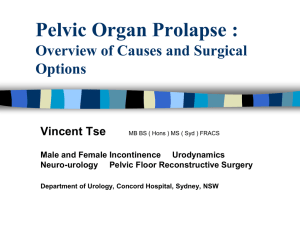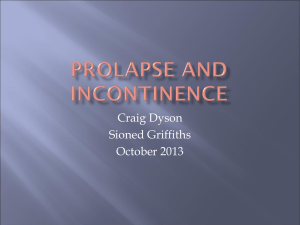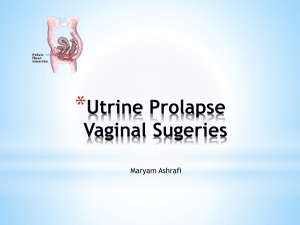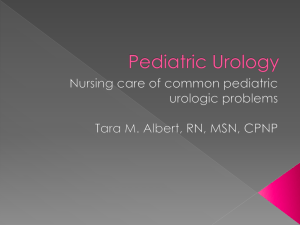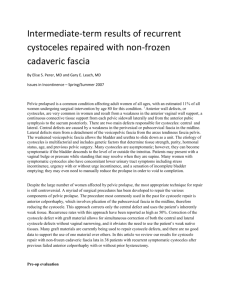Case report - WebmedCentral.com
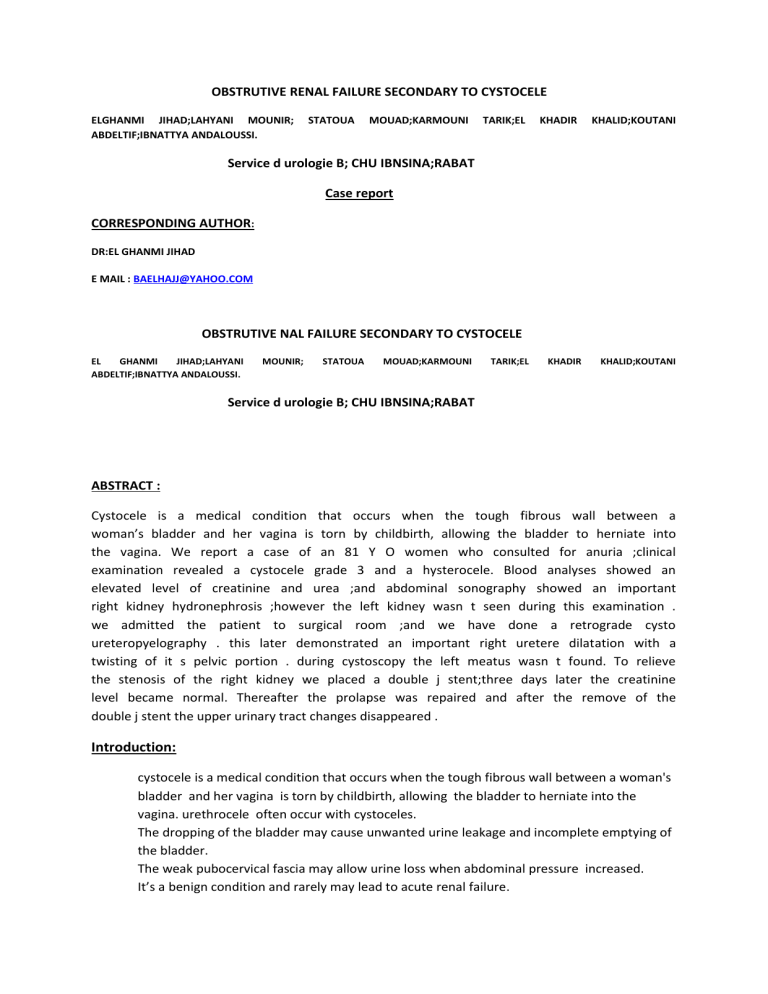
OBSTRUTIVE RENAL FAILURE SECONDARY TO CYSTOCELE
ELGHANMI JIHAD;LAHYANI MOUNIR; STATOUA MOUAD;KARMOUNI TARIK;EL KHADIR KHALID;KOUTANI
ABDELTIF;IBNATTYA ANDALOUSSI.
Service d urologie B; CHU IBNSINA;RABAT
Case report
CORRESPONDING AUTHOR :
DR:EL GHANMI JIHAD
E MAIL : BAELHAJJ@YAHOO.COM
OBSTRUTIVE NAL FAILURE SECONDARY TO CYSTOCELE
EL GHANMI JIHAD;LAHYANI MOUNIR; STATOUA MOUAD;KARMOUNI TARIK;EL KHADIR KHALID;KOUTANI
ABDELTIF;IBNATTYA ANDALOUSSI.
Service d urologie B; CHU IBNSINA;RABAT
ABSTRACT :
Cystocele is a medical condition that occurs when the tough fibrous wall between a woman’s bladder and her vagina is torn by childbirth, allowing the bladder to herniate into the vagina. We report a case of an 81 Y O women who consulted for anuria ;clinical examination revealed a cystocele grade 3 and a hysterocele. Blood analyses showed an elevated level of creatinine and urea ;and abdominal sonography showed an important right kidney hydronephrosis ;however the left kidney wasn t seen during this examination . we admitted the patient to surgical room ;and we have done a retrograde cysto ureteropyelography . this later demonstrated an important right uretere dilatation with a twisting of it s pelvic portion . during cystoscopy the left meatus wasn t found. To relieve the stenosis of the right kidney we placed a double j stent;three days later the creatinine level became normal. Thereafter the prolapse was repaired and after the remove of the double j stent the upper urinary tract changes disappeared .
Introduction: cystocele is a medical condition that occurs when the tough fibrous wall between a woman's bladder and her vagina is torn by childbirth, allowing the bladder to herniate into the vagina. urethrocele often occur with cystoceles.
The dropping of the bladder may cause unwanted urine leakage and incomplete emptying of the bladder.
The weak pubocervical fascia may allow urine loss when abdominal pressure increased.
It’s a benign condition and rarely may lead to acute renal failure.
We present here case of acute kidney failure secondary to cystocele grade 3.
Case presentation:
A 81 YO women;multipara and without any past medical history ;complainig since 6 months of urinary frequency and dysuria ;was admitted to our emergency department for anuria;
Clinical examination revealed a complete hysterocele with a grade 3 cystocele.(fig 1)
Serum analysis have shown a severe alteration of serum urea and creatinine; creatinine was
125mg/ml and urea 2.2g/L .
Abdominal ultrasonography have shown an important right kidney hydronephrosis and the left kidney wasn t visible.
Infront of this emergency situation ;the patient was admitted to the operative room for placing a double j stent hence relieving renal obstruction.
Before placing the catheter ;we have done a right retrograde uretropyelography that have enabled us to identify the cause of the obstruction that was a twisting of the pelvic uretere
(fig2and3)
During cystoscopy the left bladder meatus wasn t found;
The double j was placed successfully and after 5 days the patient serum levels of creatinine and urea became normal.(FIG4)
An abdominal scan was done confirming left kidney agenesis.
Then the patient was admitted to surgical room for repairing the prolapse;we voted for a hysterectomy and an anterior cystocele repair using a four arm synthetique mesh.
The postoperativefollow up was normal and the double j stent was removed after 3weeks and kidney fonction was controlled 2 weeks later and remained normal.
DISCUSSION:
Cystocele is a benign condition were by the bladder drops through the vaginal wall ;it can be isolated or associated withhysterocele ;rectocele and even enterocele.
It may result from a series of long –term failure of the supporting and suspension mechanisms of the uterus and vaginal wall.
The etiologies are a combination of denervation in the pelvic floor musculature ;directed injury to the pelvic floor musculature ;or defects in the endopelvic fascia and supporting ligaments.[1]
Depending to it s severity it may be graded from GRADE 1 to GRADE 4.
It may be managed by changing life styles as weight loss ;preventing constipation and in severe cases by surgery ;
Cystocele may lead to chronic urinary retention and in severe cases to renal failure.
The effect of prolapse on the uppe urinary tract ;especially the ureters has long interested researchers .
The real mecanism of hydronephrosis secondary to prolapse is not well understood.
According to BRETTAUER and °RUBIN(1923);in a series consisting of six total and four partial prolapses ;found hydronephrosis and dilated ureters in eight cases ;though four of these presented only unilateral changes.[2] ;[3] ;[4]
In their opinion the ureteral stasis might be due to obstruction of the urinay flow by kinking of the urethra and stasis in the cystocele;intramural elongation of the ureters in the bladder wall ;resulting in stenosis ;and compression of the ureters against the borders of the levator muscles or against the uterine arteries.[2]
FRANK described a patient with total prolapse who died of uremia;at autopsy the ureters were found to be dilated down to the decussation of the uterine arteries .
KLEMPNER (1942);who investigated the problem ;found ureteral dilatation in 5% of cases with first degree prolapse;in 26% of those with second degree;and in 40% of those with thid degree prolapse.the ureteral stasis was in his view dependent upon the degree of uterine descent.[2]
Our case has complete uterine and bladder prolapse with hydroureteronephrosis complicated by acute renal failure and depending on the findings of ureterocystography the twisting of the lower part of the uretere was the main etiology.
According to litterature there are different types of surgical repair of cystocele prolapse
;some authors vote for transadominal repair by colpopexy to sacral promontary others vote for transvaginal repair.
According NGCC and al transvaginal anterior colporrhaphy reinforced with a tension –free mesh in the treatment of severe or recurrent cystoceles is simple ;safe ;easily performed and is associated with a low failure rate and morbidity ;we voted in our case for a transvaginal repair using anterior colporrhaphy reinforced with a tension free four armed mesh.[5]
According to HEIDE ; when we do reduce the prolapse the changes of the upper urinary tract subsides .
For KLEMPNER after the operation of the prolapse or after pessary treatment ;the dilatation rapidly subsided in71% of the patient.
For our patient ;after the reduction of the prolapse and the removing of the double j stent the renal fonction remained normal and the upper urinary tract changes disappeared.
Conclusion:
Cystocele is a frequent benign condition that should be well managed before it becomes a lifethreatening pathology.
Reference:
1-Updated Definition of Female Pelvic Organ Prolapse
Gin-Den Chen, M.D., Soo-Cheen Ng, M.D.
Department of Obstetrics and Gynecology, Chung Shan Medical University
Hospital, Taichung, Taiwan
2-PROLAPSEOF THE UTERUS AND VAGINA CLINICAL AND THERAPEUTIC ASPECTS Review of
Six Hundred Cases BY Carl- 0 1 0 f Danielson
3-Hydronephrosis and pelvic organ prolapse.
Costantini E 1 , Lazzeri M, Mearini L, Zucchi
A, Del Zingaro M, Porena M.
4-Novalc’s Textbook of Gynecology 10th edn. Williams and Wilkins, Baltimore, MD,
1981: 369-73. 3/ Chapman RH.Ureteric obstruction due to uterine prolapse.
5-The effectiveness of transvaginal anterior colporrhaphy reinforced with polypropylene mesh in the treatment of severe cystoceles.
Ng CC
1
, Chong CY.
COMPETING INTERESTS:
No competing interests between authors.
CONTRIBUTION OF AUTHORS:
EL GHANMI JIHAD reviewed our patient’s case, data and figures, and was a major contributor in writing the manuscript. LAHYANI MOUNIR AND STATOUA MOUAD reviewed our patient’s case and data.
KARMOUNI TARIK ;EL KHADIR ;KOUTANI and IBN ATTYA were involved during the initial presentation of our patient’s case and were a major contributors in writing the manuscript.
All authors read and approved the final manuscript.
FIGURES :
FIG1 : CYSTOCELE GRADE 3 WITH HYSTEROCELE
FIGURE 2
FIGURE 3
FIG 2 AND 3 : retrogradeureterocystography showing the twisting of the pelvic part of ureters.
FIG4: A double stent catheter placed
